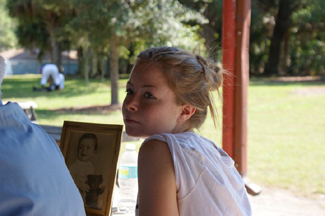Kathleen Purcell graduated from The London International School of Performing Arts in 2009 with an Advanced Certificate in French mimetic-based actor devised physical theatre. She also is continuing towards a bachelor’s degree at The New School for Public Engagement. Kathleen is a performer, writer, activist, stage electrician, stage manager, producer, and director of devised original works. She has worked with Oubliette ArtHouse, Target Margin Theater, Theater Three Collective, HERE Arts Center, Baryshnikov Arts Center, & Incubator Arts.
TMT: Describe yourself in 36 words.
KP: I am a frazzled dreamer. I work full time, am in and out of school, organize in my community and as a student activist, maintain a small garden, and I write. I want justice and love.
TMT: You’re the lead artist on A Night in the Old Marketplace, I.L. Peretz’ poetic fever dream criticism of the shtetl—small pious Jewish towns formerly found in Eastern Europe. But in 2012 when we talk about community building and social activism and collective responsibility… isn’t that the shtetl too?
KP: Possibly, but what’s interesting about the experience of the shtetl is an effort to create an oasis of Jewishness. This is reflected both in the formation of shtetl and its placement as a nostalgic icon. The shtetl has a very static quality to it. Almost paradoxically, turn of the 20th century residents of the shtetl seem to have one of two main ideological attributes: orthodoxy or socialism–both supported by the image of paradise or utopia, forever reaching into the future and actually facilitating further social paralysis. The contrast is that social activism and the concept of responsibility for one’s community in 2012 is extended very often to a global awareness, and that community organizers are likely to focus on issues, rather than visions of a perfect future (with the exception of a few zealous occupiers, which, although well documented, account for a miniscule percentage of the world’s activists, or even the number of activists working in the United States).
TMT: In these terms how important is the concept of the shtetl to the community you live in and the work you make? Is there other work, not necessarily theatre related you’re passionate about?
KP: I’m not sure I can answer that question directly. I can say that the play expresses an angst against boundaries, exemplified by the Jester. He is the perpetual malcontent–always wanting to push a little more, never satisfied with his successes. The wholesome shtetl, in this case, is a prison. In fact, the confines of reality are a prison. A Night in the Old Marketplace offers a critique of that angst, and this is something that I can connect to the accelerationist anxieties of many political and social organizers–particularly young ones–as well as entrepreneurs and salespeople who are caught in the rat race of becoming a successful capitalist. We want to be better and more effective, no matter our previous victories.
TMT: In there something you’re specifically involved in now?
KP: I organize with Free University NYC. In May and September of this year we’ve held large open-air universities in Madison Square Park, with dozens of teach-ins and workshops, primarily focused upon radical pedagogies. In some ways we are the anti-university or the anti-institution, and in others we are fighting to be considered as legitimate an entity as institutions of higher education. Concurrent with that contradiction is the ubiquitous and feckless critic. You know, the one who always has an opinion about what the project should look like, but never has a proposal for how that can happen? Yeah, that guy. Don’t you hate that guy? That’s the Jester.
TMT: Okay here’s a tangent but a good question I was asked once that I want to ask you: What’s the play or piece of music or painting that belongs to you? The thing you didn’t create that you look at or listen to and know you own?
KP: Cyberpunk novels. Particularly of the Richard Calder variety. On the outside, I’m Kathleen. On the inside, I’m a teenage anthropmorphic assasin bent on dismantling a Puritanical technocracy. One beheading at a time.
TMT: You’re a success story, you worked in the office at Target Margin and now you’re a lead artist in a TMT Lab. If you could give anyone a word of advice what would it be. I’ll translate it into Yiddish.
KP: Don’t wait around for gigs like these to happen. Create and present your work as much as possible. Living room readings are the easiest thing in the world to set up, and there are hundreds of venues in New York that do open mics. No excuses.
A Night in the Old Marketplace runs at The Brick Oct 19-20 at 10:00pm
Tickets available HERE.
